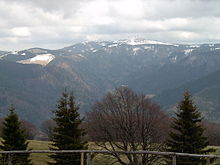Valley step


A valley step or threshold is a distinctive break in the gradient in the longitudinal profile of valleys, mostly trough valleys formed by glaciers .
Typically, a valley formed by glaciers has a series of basin shapes and thresholds in between, which are created by the locally varying depth erosion of valley glaciers . After the ice has melted, this first appears as a sequence of lakes with rapids or waterfalls in between . The transport of rubble , erosion and deposition processes in the rivers ultimately result in sequences of valley floors and gorges .

Such basin shapes with an abrupt start often appear as distinctive steps that can separate the more even valley sections from one another. Clear steps often emerged where the erosion performance of the former glacier that filled the valley suddenly increased, for example when large glaciers converged. They are then referred to as stages of confluence . Similar steps also arise when flat ice moving towards each other forms into glacier streams that can excavate the rock surface more intensely ( exaration ). If such valley steps are close to the upper end of a valley, they are also referred to as the head of the valley , otherwise they divide the valley range into often very concise individual valley sections, which can also be strung together in a chain-like manner with softer and wide basins and narrow valleys in between at steps and bells. Especially in the interior of the mountains, these valley steps form the structure of the settlement areas and lead to isolated locations that are difficult to reach.
Side valleys that meet a trough valley high above the valley floor also flow into the main valley with a clear step. The stream then falls over the trough wall of the main valley. One then speaks of a hanging valley , the step is morphologically assigned to the valley wall of the main valley, so it is not a valley step in the narrower sense described. Borderline cases of these terms are the Cartels , which typically form basins in which there is often a lake that only periodically flows over the threshold or drains completely underground.
Valley steps can also be specified in the mountain relief before glaciation, or arise entirely without the effect of the glacier, typically due to the rock's changing resistance to erosion or due to active faults . They are then only accentuated by glacial and / or fluid erosion . Examples of this are the ravine valleys in sandstones, or often only troughs in the limestone that drain below the ground, where the valley step below sinks through deep erosion.
Valley steps that were created without the involvement of glaciers can often be found in the area of strata . In the broad plains of the lower reaches, these can then represent a very characteristic structure of the course in river sections and are widely used as a major obstacle to navigability .
The valley threshold is also used in a broader sense to refer to mountain ranges that stretch across the valley, the watercourse then forms a local breakthrough valley and the mountain formation is called the Riegelberg . Such formations arise when glaciers ausgeschüft after kick-in Talverlauf pool, but then again increase (similar to the stilling basin below a waterfall), or laterally debouching glaciers later excavated another main run of Talzugs. Another form of the valley threshold is formed by old terminal moraines , then a watershed can also arise in the middle of the valley range ( valley watershed ). Similar constellations also arise through tapping , where a river course then changes the flow direction piece by piece, and from an original middle course to the local upper course of another river, and a threshold in the valley ridge remains. The bottom level can then also be the same on both sides of the valley weir - inselbergs in wide trough valleys are often characteristic remnants of an otherwise completely removed valley step or weir. Or the basin behind the threshold fills up with sediment again, so that valley steps in the narrower sense arise again (secondary valley step) - typical cases for this are ice age lakes that have silted up again.
Similar forms are also created by large mass movements , for example all of a sudden through landslides or creeping through valley thrust , or through massive wind movements ( Aeolian sediment ). Here, too, the balance between erosion and replenishment decides whether a breakthrough or a secondary stage occurs.
Valley weirs in this broader sense as well as valley steps in the narrower sense form valley passes .
Steeper levels of the valley form gorges and canyons from those having waterfalls can erode and against the flow direction, and then forms a below Canyon . Prototype examples of the latter are the Niagara Falls , which today lie between two of the American Great Lakes, and the Grand Canyon , which represents the final development of such retrograde erosion. If the erosion is insufficient to overcome the step or threshold, a local endorheic basin is created .
On the macro scale, the valley level / threshold finds a correspondence in the mountain threshold , which can isolate entire large landscapes analogously.
literature
- Stefan Rasemann: Geomorphometric structure of a mesoscale alpine geosystem. Chapter 2.3: Relief forms of the high mountains. Dissertation Rheinische Friedrich-Wilhelms-Universität Bonn, 2003, p. 77 (PDF file; 3.95 MB)